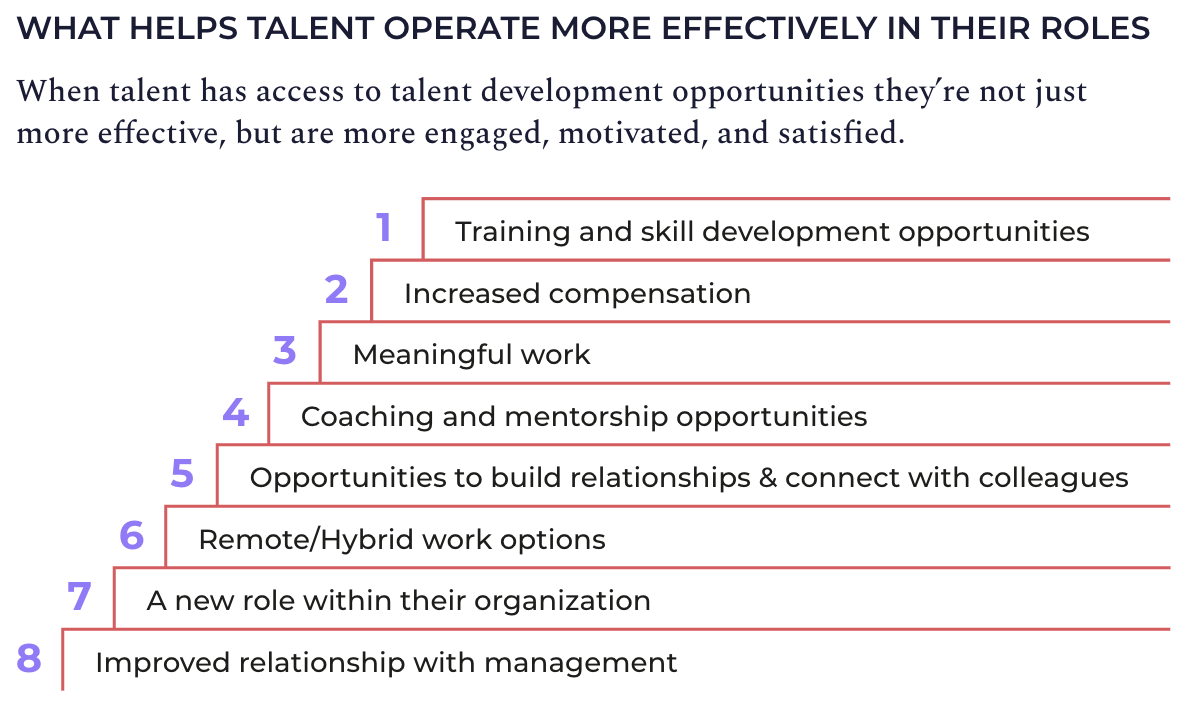
New Year, New Goals: Aligning Your Workforce Strategy with Business Priorities
Advancement opportunities. Product innovation. Cutting-edge technology adoption. Talent optimization and development.
Leaders are constantly looking for ways to deliver growth for their business and workforce, striving to reach the goals they set the previous year. As we approach 2025, upcoming strategic priorities and business objectives are top of mind, whether those plans were finalized and shared months ago or in the finishing stages.
But how many employees actually have visibility into these plans? And understand their role in helping achieve the set goals? Research shows recent dips in perception of leadership with only 27% of employees saying they are very confident in their company’s future. 2024 also saw the first drop since 2008 in the percentage of employees who strongly agree their supervisor is an active supporter of the changes that affect their work group.
As the workplace continues its rapid shift, it’s clear employees seek more consistent, proactive communication from their leaders. This is especially true with regards to roadmaps, priorities, growth strategies, and more, which help instill confidence in the workforce that there is a plan and indicates how they ladder up to it.
According to Deloitte’s 2024 Global Human Capital Trends research, 86% of leaders surveyed said more transparency equates to greater trust and confidence from employees.
As we head into the New Year, how can organizations effectively communicate their key goals and objectives? And in doing so, help ensure all employees are in lockstep with what’s needed for a successful year?
Skillsoft surveyed more than 2,100 global workers across the United States, UK, and Germany to explore these questions, digging into workplace challenges and perceived levels of preparedness going into 2025. The survey examined:
- What employees perceive as top challenges facing them and their companies
- Obstacles they anticipate facing in 2025
- Company goals for 2025 and whether respondents felt prepared to meet them
- What would make workers more effective in their roles, and more.
Keep reading to see the key takeaways of the survey — or jump to the in-depth research.
Strategic Goals are Subject to Failure due to Skill Gaps and Workplace Challenges
Less than half (48%) of respondents say their organizations have shared strategic goals and priorities for the coming year. Of those who say their leadership has done so, the top priority is improving operational efficiency (48%), followed by increasing revenue and profitability (46%), and enhancing the customer experience (39%).

For the other half of the workforce that hasn’t been informed of their organization’s objectives for 2025, how can their plans be expected to align with wider goals, much less establish action items or performance indicators? Communication of the company strategy early and often helps ensure everyone is aligned to a common framework. It also helps employees develop skills that support the strategy.
Only a third of respondents say they believe their skills strongly align with their organization’s strategic priorities. Among those who said they are unsatisfied in their current role, that number drops by nearly 15 percentage points – an important statistic when respondents identified talent retention and acquisition as the most common organizational challenge.
When employees’ most common work-related challenges are burnout (39%), decreased motivation (35%), and overwhelming workload (35%), leaders must consider the skill sets of their workforce when creating strategic goals to foster engagement and increase the chances of success. And, there must be employee growth plans in place to develop their talent in a way that will help achieve the objectives.
Leadership and Management Are Underprioritized and Unrealized
Of the challenges respondents expect their organizations to face in 2025, leadership and management were the third most common answer, above regulatory changes and even data privacy and security. Despite this, less than a fifth of respondents said enhancing leadership and management was a strategic goal for their company in 2025, leaving the hurdle unaddressed and under prioritized .

Our survey also examined the perceived influence of the US presidential election on the workplace, with nearly three quarters (73%) of respondents anticipating some degree of impact.
Respondents hypothesize a positive impact on areas like AI tools in the workplace and employee development and career pathing. Meanwhile, they anticipate a negative impact on factors like regulatory compliance requirements and employee morale and engagement. If companies are to effectively direct their employees through the shifts in the political climate, they must prioritize leadership and management.
Skills Gaps Are Still Present – But Companies Are Focused Elsewhere
Alarmingly, employees say that closing skill gaps is one of their organization’s least prioritized goals for 2025. When only a third of employees believe their skills are strongly aligned to strategic priorities and 23% feel extremely prepared to handle future work-related challenges, developing talent must be top-of-mind.

Respondents felt the top organizational challenge for 2025 will be talent acquisition and retention (31%). Skillsoft’s recent 2024 IT Skills and Salary Report found similar challenges specific to tech teams with skill gaps and talent retention among the top four key barriers for IT decision-makers.
Offering upskilling opportunities supports talent acquisition and retention on two fronts. A balance between internal talent development and external hiring efforts splits the load of building industry-leading teams while offering a top incentive for job seekers and current employees alike.
Further, industry-specific certifications have clear financial, psychological, and business benefits, including an estimated $30,000 in added value per certified employee, as well as increased work quality and employee engagement.
Employees Are Clear About What Works
The most effective leaders optimize their talent and their talents’ skills to achieve business goals. According to our research, organizations can better support employees to develop these skills with personalized training tailored to their role (35%), frequent and updated training sessions to keep up with industry best practices (33%), and an increase in mentoring and coaching opportunities (32%).
Personalizing training to specific individuals allows experience, responsibility, legislation, culture, and more to form the most effective learning path. This added context ensures employees are staying on the bleeding edge of their industry for everything from compliance to communication styles. Moreover, the research found that respondents who feel more prepared for future workplace challenges are more satisfied with their current role.
Moving Forward: Preparing for the Challenges of 2025
As we head into the new year, businesses expect new challenges, but are they prepared?
Establishing broader goals like increasing operational efficiency or increasing revenue must be coupled with actionable steps within the current workforce's skill set or clear plans to develop those skill sets. Otherwise, companies are setting goals that seem unachievable, contributing to the burnout, exhaustion, and worry felt by their employees. A lack of investment in employee development would handicap an adaptable and agile workforce capable of thriving with a proper roadmap.
- Invest in programs that develop leadership and power skills such as communication, empathy, decision-making, and delegating to enhance transparency and trustworthiness across the organizational structure. Skillsoft’s recent State of Enterprise Skilling research found power skills were most important for success in today’s workplace.
- Create a culture of continuous improvement and empowerment. By embedding learning in company priorities, organizations can foster an environment where talent transformation becomes an integral part of daily operations.
- Reinforce this culture of growth with diverse training options. Expanding on traditional digital learning – online video lectures, digital workbooks, etc. – with live, instructor-led training, interactive experiences, coaching workshops, or mentorship opportunities produces a workplace driven by excellence, creativity, and innovation.
- Take advantage of AI and automation technology, too, with use cases centered largely around personalization and ad hoc learning. AI-driven tools can help identify skill gaps, recommend personalized training modules, and provide real-time feedback during assessments, filling gaps for the most effective support needs.
Addressing the misalignment of strategic goals and talent skills through comprehensive training programs is essential to meet business priorities set for 2025. By fostering a culture of continuous improvement and empowerment, companies can ensure their workforce is resilient, adaptable, and ready to tackle future challenges.
Research Methodology
Skillsoft’s research survey was conducted online in October 2024 through the Pollfish platform. The survey yielded 2,150 complete responses from full-time workers across various industries and roles in the United States, United Kingdom, and Germany.


